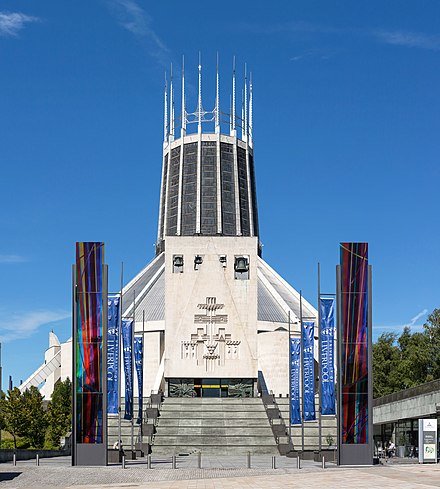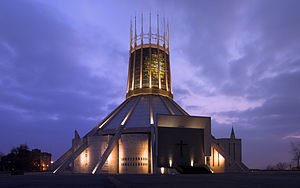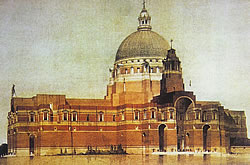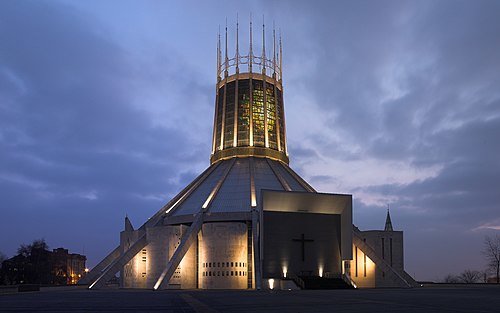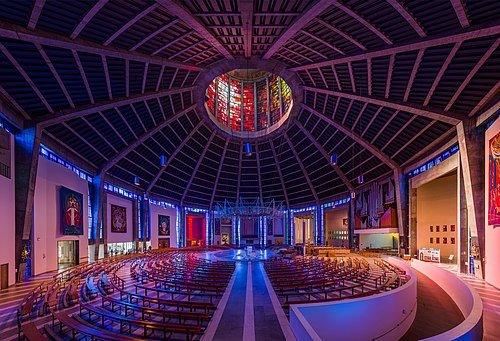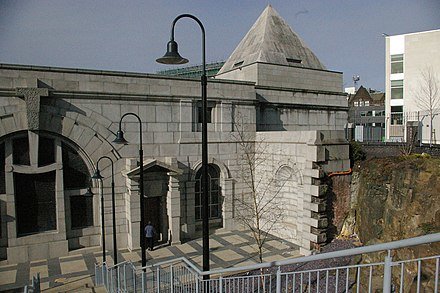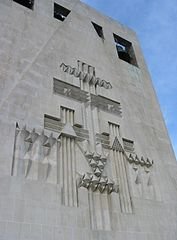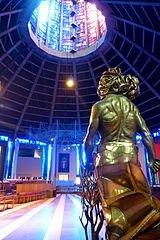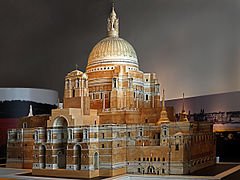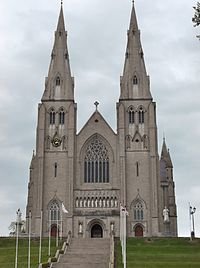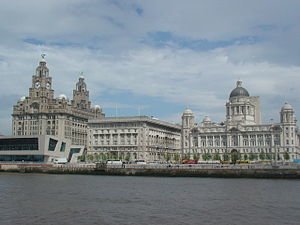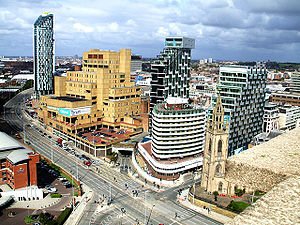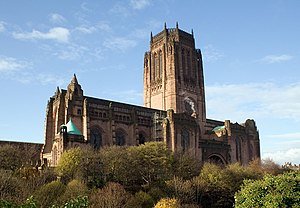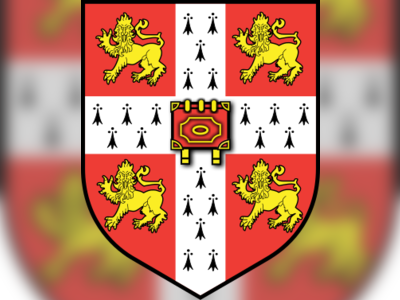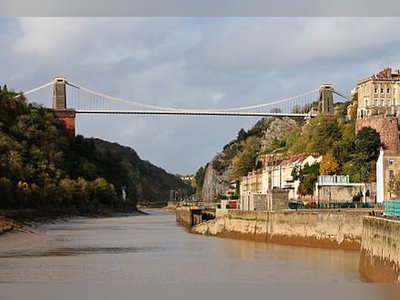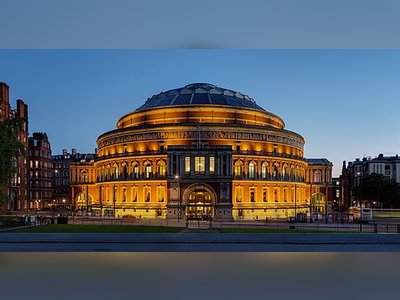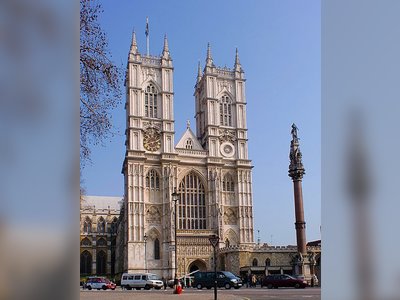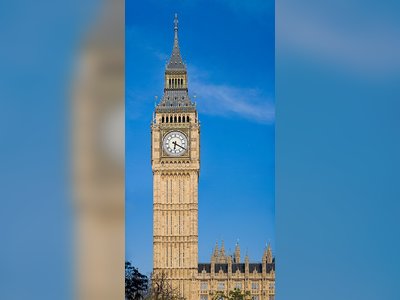British Heritage
Remember, Cherish, Learn.
beta
Liverpool Metropolitan Cathedral
A Testament to British Heritage.
Liverpool Metropolitan Cathedral, colloquially known as the Metropolitan Cathedral of Christ the King, is a crowning jewel in British architectural heritage and a symbol of the religious diversity that marks the United Kingdom's cultural landscape. The Cathedral, which locals affectionately call "Paddy's Wigwam," stands as a testament to the Roman Catholic Archdiocese of Liverpool's historical endurance and evolving faith community. Distinguished as a Grade II* Metropolitan Cathedral, this prominent Liverpool landmark embodies the innovative spirit of British architecture and stands as a testament to religious, cultural, and architectural ingenuity.
The seeds of the Liverpool Metropolitan Cathedral were planted in the mid-19th century during the Great Irish Famine (1845–1852). This calamitous period saw the Catholic population of Liverpool surge as about half a million Irish immigrants, primarily Catholic, fled to England. A significant number of these immigrants remained in the city, while others embarked on their journey to North America from Liverpool.
Recognizing the burgeoning Catholic community, the co-adjutor Bishop of Liverpool, Alexander Goss, perceived a need for a grand cathedral. He chose the grounds of St. Edward's College on St. Domingo Road, Everton, for its location. In 1853, Goss commissioned Edward Welby Pugin to design the cathedral. Pugin, a respected architect, completed the Lady chapel by 1856, now named Our Lady Immaculate. However, financial constraints directed resources towards Catholic education, halting further construction. The chapel served as a parish church for the local Catholic community until its demolition in the 1980s.
The dream of a grand cathedral was revisited in 1930 with the purchase of the former Brownlow Hill workhouse site. Sir Edwin Lutyens, a renowned British architect, was commissioned to design a cathedral that would provide a fitting counterpoint to the Neo-gothic Anglican cathedral on Hope Street designed by Giles Gilbert Scott.
Lutyens conceived a colossal structure, which, if completed, would have been the second-largest church globally. The proposed cathedral was to feature the world's largest dome, exceeding the diameter of St. Peter's Basilica's dome in Vatican City. Funded primarily by the working-class Catholics of the industrial port, construction began on 5 June 1933. However, World War II and escalating costs stalled the building process in 1941. Only the crypt was completed when the plan was abandoned as too costly in 1958. The architectural model of the Lutyens cathedral remains displayed at the Museum of Liverpool.
The design torch was then passed to Adrian Gilbert Scott, who proposed a scaled-down version of Lutyens' design. Despite maintaining the concept of the massive dome, Scott's plans faced criticism and were subsequently dismissed.
The present form of the Cathedral was realised by the architectural genius of Sir Frederick Gibberd. The groundbreaking design emerged victorious in a worldwide competition, and construction commenced in October 1962. A mere five years later, the completed cathedral was consecrated on the Feast of Pentecost, 14 May 1967.
Gibberd's design was both innovative and controversial. The architect faced criticism, including allegations of architectural flaws leading to leaks and defects in the mosaic tiles. Despite these challenges, the design has also been acknowledged for its originality and ambitiousness. Some critics compare it to Oscar Niemeyer's creations in Brasilia, although any resemblance is deemed superficial.
The Cathedral's concept was to provide a congregation of 2,000 with clear visibility of the altar, fostering greater participation in the Mass. Additionally, Gibberd was tasked with incorporating the existing Lutyens crypt into the design. This was achieved by developing a circular building with the altar at its centre and repurposing the crypt's roof into an elevated platform. The construction contract was awarded to Taylor Woodrow.
The Metropolitan Cathedral's exterior is a distinctive architectural marvel. Constructed of concrete and clad in Portland stone, the cathedral's circular plan culminates in a conical tower. This unique form is supported by 16 boomerang-shaped concrete trusses held together by two ring beams. Attached flying buttresses impart the cathedral with its iconic tent-like appearance. Rising from the upper ring beam, a lantern tower filled with stained glass windows dominates, crowned with a series of pinnacles.
Upon entering the cathedral, one is greeted by the altar made of white marble from Skopje, North Macedonia. The circular interior, complemented by marble flooring and benches designed by Frank Knight, focuses on the altar. Overhead, a tower features large areas of stained glass designed by John Piper and Patrick Reyntiens, representing the Trinity.
The Liverpool Metropolitan Cathedral is more than just an architectural marvel. It is a testament to the endurance of the Catholic community in Liverpool, a symbol of the city's historic and ongoing relationship with Irish immigrants, and a testament to the evolution of architectural styles and tastes over time.
Throughout its history, the Cathedral has faced its share of challenges, from financial difficulties to construction problems. Nevertheless, the cathedral has remained a prominent symbol of faith and a key feature of Liverpool's architectural landscape.
Even now, the cathedral continues to contribute to Liverpool's cultural heritage, hosting events such as the Liverpool Beer Festival and examinations for University of Liverpool students. It stands as a testament to the city's historical resilience and its enduring commitment to architectural innovation and cultural diversity.
Today, the Liverpool Metropolitan Cathedral is not just a place of worship. It is an integral part of the cultural and architectural fabric of the United Kingdom, a tribute to the nation's diverse religious traditions, and a celebration of its commitment to architectural innovation. Whether seen through the lens of heritage, religion, or architecture, the Liverpool Metropolitan Cathedral stands as a shining beacon of British history and identity.
A Long-awaited Sanctuary: Pugin's Design and the Early Beginnings
The seeds of the Liverpool Metropolitan Cathedral were planted in the mid-19th century during the Great Irish Famine (1845–1852). This calamitous period saw the Catholic population of Liverpool surge as about half a million Irish immigrants, primarily Catholic, fled to England. A significant number of these immigrants remained in the city, while others embarked on their journey to North America from Liverpool.
Recognizing the burgeoning Catholic community, the co-adjutor Bishop of Liverpool, Alexander Goss, perceived a need for a grand cathedral. He chose the grounds of St. Edward's College on St. Domingo Road, Everton, for its location. In 1853, Goss commissioned Edward Welby Pugin to design the cathedral. Pugin, a respected architect, completed the Lady chapel by 1856, now named Our Lady Immaculate. However, financial constraints directed resources towards Catholic education, halting further construction. The chapel served as a parish church for the local Catholic community until its demolition in the 1980s.
Building on Dreams: Lutyens and Scott's Proposals
The dream of a grand cathedral was revisited in 1930 with the purchase of the former Brownlow Hill workhouse site. Sir Edwin Lutyens, a renowned British architect, was commissioned to design a cathedral that would provide a fitting counterpoint to the Neo-gothic Anglican cathedral on Hope Street designed by Giles Gilbert Scott.
Lutyens conceived a colossal structure, which, if completed, would have been the second-largest church globally. The proposed cathedral was to feature the world's largest dome, exceeding the diameter of St. Peter's Basilica's dome in Vatican City. Funded primarily by the working-class Catholics of the industrial port, construction began on 5 June 1933. However, World War II and escalating costs stalled the building process in 1941. Only the crypt was completed when the plan was abandoned as too costly in 1958. The architectural model of the Lutyens cathedral remains displayed at the Museum of Liverpool.
The design torch was then passed to Adrian Gilbert Scott, who proposed a scaled-down version of Lutyens' design. Despite maintaining the concept of the massive dome, Scott's plans faced criticism and were subsequently dismissed.
Gibberd's Groundbreaking Design
The present form of the Cathedral was realised by the architectural genius of Sir Frederick Gibberd. The groundbreaking design emerged victorious in a worldwide competition, and construction commenced in October 1962. A mere five years later, the completed cathedral was consecrated on the Feast of Pentecost, 14 May 1967.
Gibberd's design was both innovative and controversial. The architect faced criticism, including allegations of architectural flaws leading to leaks and defects in the mosaic tiles. Despite these challenges, the design has also been acknowledged for its originality and ambitiousness. Some critics compare it to Oscar Niemeyer's creations in Brasilia, although any resemblance is deemed superficial.
The Cathedral's concept was to provide a congregation of 2,000 with clear visibility of the altar, fostering greater participation in the Mass. Additionally, Gibberd was tasked with incorporating the existing Lutyens crypt into the design. This was achieved by developing a circular building with the altar at its centre and repurposing the crypt's roof into an elevated platform. The construction contract was awarded to Taylor Woodrow.
The Majestic Exterior and Interior
The Metropolitan Cathedral's exterior is a distinctive architectural marvel. Constructed of concrete and clad in Portland stone, the cathedral's circular plan culminates in a conical tower. This unique form is supported by 16 boomerang-shaped concrete trusses held together by two ring beams. Attached flying buttresses impart the cathedral with its iconic tent-like appearance. Rising from the upper ring beam, a lantern tower filled with stained glass windows dominates, crowned with a series of pinnacles.
Upon entering the cathedral, one is greeted by the altar made of white marble from Skopje, North Macedonia. The circular interior, complemented by marble flooring and benches designed by Frank Knight, focuses on the altar. Overhead, a tower features large areas of stained glass designed by John Piper and Patrick Reyntiens, representing the Trinity.
The Legacy of the Liverpool Metropolitan Cathedral
The Liverpool Metropolitan Cathedral is more than just an architectural marvel. It is a testament to the endurance of the Catholic community in Liverpool, a symbol of the city's historic and ongoing relationship with Irish immigrants, and a testament to the evolution of architectural styles and tastes over time.
Throughout its history, the Cathedral has faced its share of challenges, from financial difficulties to construction problems. Nevertheless, the cathedral has remained a prominent symbol of faith and a key feature of Liverpool's architectural landscape.
Even now, the cathedral continues to contribute to Liverpool's cultural heritage, hosting events such as the Liverpool Beer Festival and examinations for University of Liverpool students. It stands as a testament to the city's historical resilience and its enduring commitment to architectural innovation and cultural diversity.
Today, the Liverpool Metropolitan Cathedral is not just a place of worship. It is an integral part of the cultural and architectural fabric of the United Kingdom, a tribute to the nation's diverse religious traditions, and a celebration of its commitment to architectural innovation. Whether seen through the lens of heritage, religion, or architecture, the Liverpool Metropolitan Cathedral stands as a shining beacon of British history and identity.
- Liverpool Metropolitan Cathedralen.wikipedia.org
